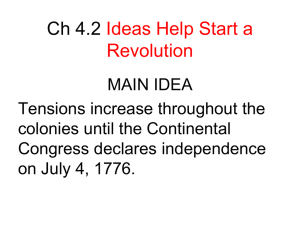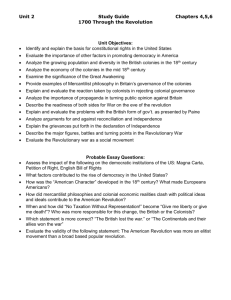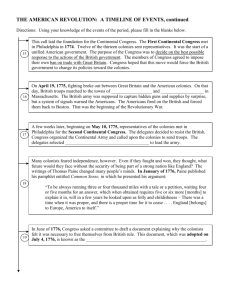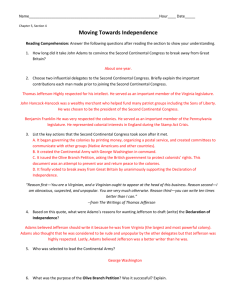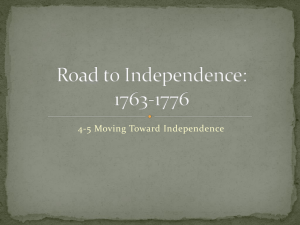Chapter 5 Lesson 4 Notes “Declaring Independence” The Second
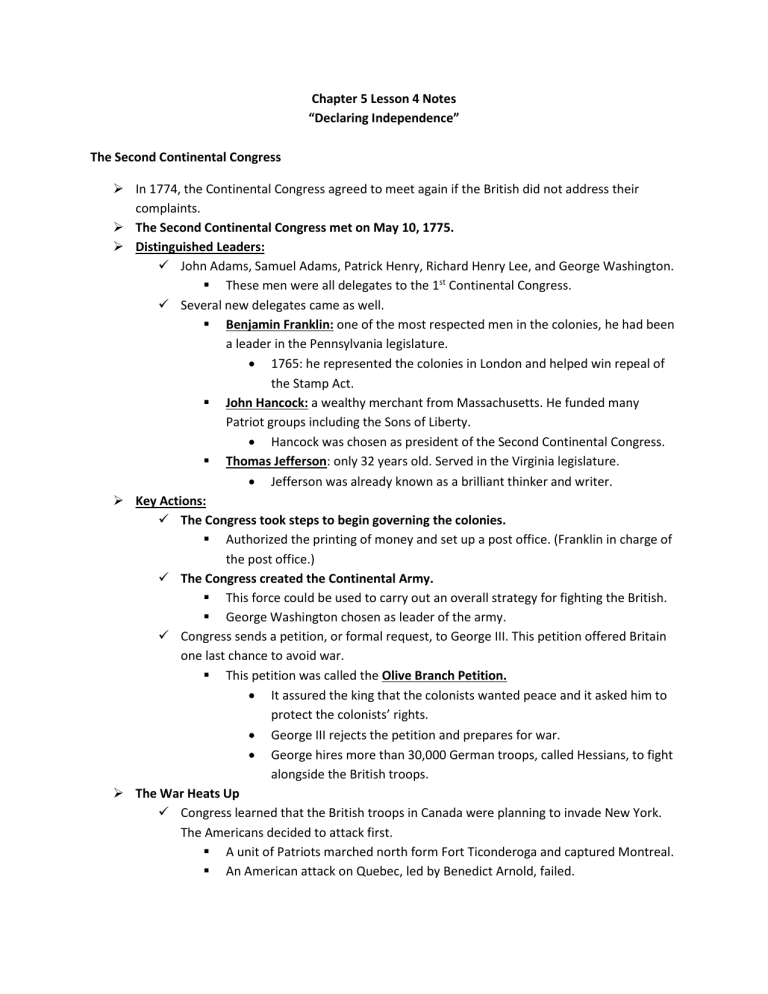
Chapter 5 Lesson 4 Notes
“Declaring Independence”
The Second Continental Congress
In 1774, the Continental Congress agreed to meet again if the British did not address their complaints.
The Second Continental Congress met on May 10, 1775.
Distinguished Leaders:
John Adams, Samuel Adams, Patrick Henry, Richard Henry Lee, and George Washington.
These men were all delegates to the 1 st Continental Congress.
Several new delegates came as well.
Benjamin Franklin: one of the most respected men in the colonies, he had been a leader in the Pennsylvania legislature.
1765: he represented the colonies in London and helped win repeal of the Stamp Act.
John Hancock: a wealthy merchant from Massachusetts. He funded many
Patriot groups including the Sons of Liberty.
Hancock was chosen as president of the Second Continental Congress.
Thomas Jefferson: only 32 years old. Served in the Virginia legislature.
Jefferson was already known as a brilliant thinker and writer.
Key Actions:
The Congress took steps to begin governing the colonies.
Authorized the printing of money and set up a post office. (Franklin in charge of the post office.)
The Congress created the Continental Army.
This force could be used to carry out an overall strategy for fighting the British.
George Washington chosen as leader of the army.
Congress sends a petition, or formal request, to George III. This petition offered Britain one last chance to avoid war.
This petition was called the Olive Branch Petition.
It assured the king that the colonists wanted peace and it asked him to protect the colonists’ rights.
George III rejects the petition and prepares for war.
George hires more than 30,000 German troops, called Hessians, to fight alongside the British troops.
The War Heats Up
Congress learned that the British troops in Canada were planning to invade New York.
The Americans decided to attack first.
A unit of Patriots marched north form Fort Ticonderoga and captured Montreal.
An American attack on Quebec, led by Benedict Arnold, failed.
Washington reached the Boston area in July 1775, a few weeks after the Battle of
Bunker Hill.
The British held Boston, but the Patriot militia ringed the city.
Washington realized that his men lacked discipline. He began to turn the civilians into trained soldiers.
Washington also needed weapons. He arranged to have dozens of cannons hauled 300 miles from Fort Ticonderoga.
March 1776: Washington now thinks his army is ready to fight and under the cover of darkness he moves his soldiers and cannons into position overlooking Boston.
This move surprised the British, they realized they were now within range of
Washington’s cannons.
General William Howe ordered his soldiers to board ships and withdraw from
Boston. The British sailed away to Halifax, Nova Scotia, a part of Canada.
March 17: Washington led his troops into Boston.
Moving Toward Independence
Support for independence was growing.
Thomas Paine influenced opinions throughout the colonies.
Arrived in 1774 from England.
January 1776: Paine published a pamphlet called Common Sense.
Paine called for a complete break from British rule.
“Everything that is right or reasonable pleads for separation. The blood of the slain, the weeping voice of nature cries, ‘TIS TIME TO PART.”
Declaring Independence
June 1776: Virginia’s Richard Henry Lee offered a bold resolution.
“That these United Colonies are, and of right out to be, free and independent
States… and that all political connection between them and the State of Great
Britain is, and ought to be, totally dissolved.”
Congress debated Lee’s resolution. Some delegates still thought the colonists should not form a separate nation. Others argued that war had already begun and they should be free.
Writing the Declaration
While Congress was debating, they appointed a committee to write a declaration of independence.
Drafting Committee:
John Adams, Benjamin Franklin, Thomas Jefferson, Robert Livingston, and Roger
Sherman formed the committee.
Adams asked Jefferson to write the first draft.
Adams persuaded him by saying: “Reason first- You are a Virginian, and a
Virginian ought to appear at the head of this business. Reason second- I am obnoxious, suspected, and unpopular. You are very much otherwise. Reason third-you can write ten times better than I can.”
Jefferson drew on ideas from English philosopher John Locke.
In the 1690s, Locke expressed the idea that people are born with certain natural rights to life, liberty, and property. Locke also wrote that people form governments to protect those rights, and that a government interfering with those rights could be overthrown. Jefferson and other
Patriots agreed with Locke.
July 2, 1776: Congress voted on Lee’s resolution. 12 colonies voted for independence,
NY did not vote but late announced its support.
July 4, 1776: after making some changes to Jefferson’s draft, Congress approved the document. Hancock signed the document first, eventually 56 delegates signed.
Copies were printed and sent out across the colonies. George Washington had it read to his troops in New York City on July 9 th .


